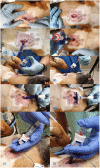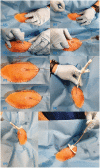Prehospital Emergency Cricothyrotomy in Dogs Part 1: Experiences With Commercial Cricothyrotomy Kits
- PMID: 34604369
- PMCID: PMC8483268
- DOI: 10.3389/fvets.2021.705695
Prehospital Emergency Cricothyrotomy in Dogs Part 1: Experiences With Commercial Cricothyrotomy Kits
Abstract
The surgical cricothyrotomy (CTT) has been recommended for emergency front of neck airway access (eFONA) during a cannot intubate, cannot oxygenate scenario for military working dogs (MWD) and civilian law enforcement working dogs (operational K9s). In prehospital and austere environments, combat medics and emergency medical service providers are expected to administer emergency medical care to working dogs and may only have emergency airway kits designed for humans at their disposal. The objective of this article is to provide a detailed description of the application of such devices in cadaver dogs and highlight potential alterations to manufacturer guidelines required for successful tube placement. The kits evaluated included the Portex® PCK, Melker universal cricothyrotomy kit and H&H® emergency cricothyrotomy kit. A novel technique for awake cricothyrotomy in the dog is also described, which can also be considered for in-hospital use, together with the open surgical method described for the H&H® kit. To the authors' knowledge, this is the first publication documenting and providing instruction on the application of commercial cricothyrotomy kits in dogs.
Keywords: CICO; cricothyrotomy; difficult airway; intubation; melker; military working dogs; operational K9; portex.
Copyright © 2021 Hardjo, Palmer and Haworth.
Conflict of interest statement
The Portex PCK was unconditionally donated by Smiths Medical Australia. The authors declare that the research was conducted in the absence of any commercial or financial relationships that could be construed as a potential conflict of interest.
Figures









Similar articles
-
Pre-hospital emergency cricothyrotomy in dogs part 2: Airway sealing and ventilation using cricothyrotomy tubes.Front Vet Sci. 2023 Feb 17;10:1129462. doi: 10.3389/fvets.2023.1129462. eCollection 2023. Front Vet Sci. 2023. PMID: 36876002 Free PMC article.
-
Concepts of Prehospital Advanced Airway Management in the Operational K9: A Focus on Cricothyrotomy.J Spec Oper Med. 2019 Spring;19(1):99-106. doi: 10.55460/KV13-RV6C. J Spec Oper Med. 2019. PMID: 30859536
-
A comparison of three techniques for cricothyrotomy on a manikin.Can J Respir Ther. 2017 Spring;53(2):29-32. Epub 2017 May 1. Can J Respir Ther. 2017. PMID: 30996627 Free PMC article.
-
Prehospital Cricothyrotomy: A Narrative Review of Technical, Educational, and Operational Considerations for Procedure Optimization.J Emerg Med. 2025 Mar;70:19-34. doi: 10.1016/j.jemermed.2024.08.018. Epub 2024 Sep 3. J Emerg Med. 2025. PMID: 39915151 Review.
-
Optimizing emergent surgical cricothyrotomy for use in austere environments.Wilderness Environ Med. 2013 Mar;24(1):53-66. doi: 10.1016/j.wem.2012.07.003. Epub 2012 Oct 10. Wilderness Environ Med. 2013. PMID: 23062323 Review.
Cited by
-
Elective cricothyrotomy in a dog with transient laryngeal paralysis secondary to Australian paralysis tick (Ixodes holocyclus) envenomation.Aust Vet J. 2022 Sep;100(9):440-445. doi: 10.1111/avj.13175. Epub 2022 May 26. Aust Vet J. 2022. PMID: 35615962 Free PMC article.
-
Pilot cadaveric study on the feasibility of cricothyroidotomy and the associated complications in 30 cats.Front Vet Sci. 2024 Apr 8;11:1365780. doi: 10.3389/fvets.2024.1365780. eCollection 2024. Front Vet Sci. 2024. PMID: 38650852 Free PMC article.
References
-
- Hammerstrom ML. Ground dog day lessons don't have to be relearned in the use of dogs in combat. California: Monterey. (2005).
-
- Lagutchik M, Baker J, Brown J, Burghardt W, Enroth M, Flournoy S, et al. . Clinical practice guidelines for military working dogs: United States Military (2018). Available online at: https://jts.amedd.army.mil/assets/docs/cpgs/Military_Working_Dog_CPG_12_...
LinkOut - more resources
Full Text Sources

